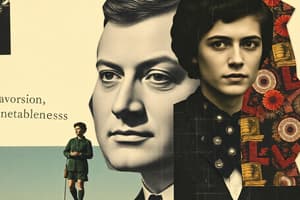Podcast
Questions and Answers
What physiological basis does the position on the Extraversion spectrum depend on?
What physiological basis does the position on the Extraversion spectrum depend on?
- Cortical arousal (correct)
- SNS responsiveness
- Limbic system activity
- Sensory stimuli processing
How does the Ascending Reticular Activating System (ARAS) affect introverts and extraverts?
How does the Ascending Reticular Activating System (ARAS) affect introverts and extraverts?
- It manages responses to cognitive stimuli.
- It leads extraverts to avoid stimulation.
- It causes higher arousal in introverts.
- It manages arousal caused by sensory stimuli. (correct)
What characterizes the arousal levels of introverts compared to extraverts?
What characterizes the arousal levels of introverts compared to extraverts?
- Introverts seek stimulation, while extraverts avoid it.
- Introverts have lower arousal and seek to avoid overstimulation. (correct)
- Introverts react more strongly to sensory stimuli than extraverts.
- Introverts have higher arousal than extraverts.
Which system is involved in managing arousal from emotional stimuli according to Eysenck's theories?
Which system is involved in managing arousal from emotional stimuli according to Eysenck's theories?
What evidence supports Eysenck's theory on extraversion?
What evidence supports Eysenck's theory on extraversion?
What is meant by the term 'phenotype' in the context of personality?
What is meant by the term 'phenotype' in the context of personality?
Which example best illustrates a neural correlate of personality?
Which example best illustrates a neural correlate of personality?
Research into genetic heritability primarily focuses on what aspect?
Research into genetic heritability primarily focuses on what aspect?
How do biological theories of personality generally structure their framework?
How do biological theories of personality generally structure their framework?
What role do non-functional sequences in chromosomes play within the context of personality?
What role do non-functional sequences in chromosomes play within the context of personality?
What aspect of personality does asexuality in hyenas primarily exhibit?
What aspect of personality does asexuality in hyenas primarily exhibit?
Which specific method was mentioned for evaluating animal personality?
Which specific method was mentioned for evaluating animal personality?
Which species demonstrated repeatability in exploratory behavior as observed in Dingemanse et al. (2002)?
Which species demonstrated repeatability in exploratory behavior as observed in Dingemanse et al. (2002)?
In the study by Gosling & John (1999), which personality trait was most frequently observed in the evaluated animals?
In the study by Gosling & John (1999), which personality trait was most frequently observed in the evaluated animals?
What did the research suggest about projecting human understanding onto animal behavior?
What did the research suggest about projecting human understanding onto animal behavior?
Which system is associated with impulsivity and positive emotion?
Which system is associated with impulsivity and positive emotion?
What does the Behavioural Inhibition System primarily signal?
What does the Behavioural Inhibition System primarily signal?
According to Gray's Reinforcement Sensitivity Theory, which of the following is NOT one of the three neurological systems underlying personality?
According to Gray's Reinforcement Sensitivity Theory, which of the following is NOT one of the three neurological systems underlying personality?
What aspect of personality does the Fight-Flight-Freeze system primarily respond to?
What aspect of personality does the Fight-Flight-Freeze system primarily respond to?
What is a key problem with Eysenck's Theory related to Neuroticism (N)?
What is a key problem with Eysenck's Theory related to Neuroticism (N)?
What did the 2018 Hierarchical Reinforcement Sensitivity Theory study utilize to predict personality traits?
What did the 2018 Hierarchical Reinforcement Sensitivity Theory study utilize to predict personality traits?
How are behavioral patterns shaped according to the Reinforcement Sensitivity Theory?
How are behavioral patterns shaped according to the Reinforcement Sensitivity Theory?
What is one key concept derived from individual differences within the Reinforcement Sensitivity Theory?
What is one key concept derived from individual differences within the Reinforcement Sensitivity Theory?
What does the Behavioral Activation System (BAS) primarily seek?
What does the Behavioral Activation System (BAS) primarily seek?
How did caffeine affect the performance of introverts and extroverts according to the evidence for Gray's theory?
How did caffeine affect the performance of introverts and extroverts according to the evidence for Gray's theory?
Which personality system is related to the volume of the hippocampus?
Which personality system is related to the volume of the hippocampus?
What is the basic driver of evolutionary arguments in psychology?
What is the basic driver of evolutionary arguments in psychology?
Which index measures the likelihood to ascend within a social hierarchy?
Which index measures the likelihood to ascend within a social hierarchy?
What is a notable risk associated with high levels of extraversion (E)?
What is a notable risk associated with high levels of extraversion (E)?
What does the Locus of Control (LOC) measure in response to social dilemmas?
What does the Locus of Control (LOC) measure in response to social dilemmas?
Which statement regarding personality dimensions is accurate according to Nettle's findings?
Which statement regarding personality dimensions is accurate according to Nettle's findings?
What does dominant genetic variance refer to?
What does dominant genetic variance refer to?
In the context of twin studies, what is the main implication of comparing MZ twins to DZ twins?
In the context of twin studies, what is the main implication of comparing MZ twins to DZ twins?
What percentage of variance in personality traits is estimated to be accounted for by genetic influences?
What percentage of variance in personality traits is estimated to be accounted for by genetic influences?
Which of the following factors is NOT typically considered part of the non-shared environment?
Which of the following factors is NOT typically considered part of the non-shared environment?
What is the role of the ORDU gene in personality traits?
What is the role of the ORDU gene in personality traits?
According to Ricmann (1997), how is heritability calculated?
According to Ricmann (1997), how is heritability calculated?
What is a significant challenge in identifying common genetic variations that impact personality?
What is a significant challenge in identifying common genetic variations that impact personality?
Which of the following is NOT a factor considered in genetic studies on personality?
Which of the following is NOT a factor considered in genetic studies on personality?
Flashcards
Phenotype
Phenotype
The outward expression of an organism's traits, determined by the interaction of genes and environment.
Genetic Heritability
Genetic Heritability
A measure of how much of a trait's variation is due to genetic factors.
Neural Correlates of Personality
Neural Correlates of Personality
The study of how brain structures relate to personality traits.
Dorsolateral Prefrontal Cortex (DLPFC)
Dorsolateral Prefrontal Cortex (DLPFC)
Signup and view all the flashcards
Gene Expression
Gene Expression
Signup and view all the flashcards
Arousal Level
Arousal Level
Signup and view all the flashcards
Ascending Reticular Activating System (ARAS)
Ascending Reticular Activating System (ARAS)
Signup and view all the flashcards
Extraversion
Extraversion
Signup and view all the flashcards
Introversion
Introversion
Signup and view all the flashcards
Limbic System
Limbic System
Signup and view all the flashcards
Additive genetic variance
Additive genetic variance
Signup and view all the flashcards
Dominant genetic variance
Dominant genetic variance
Signup and view all the flashcards
Epistatic genetic variance
Epistatic genetic variance
Signup and view all the flashcards
Non-shared environment
Non-shared environment
Signup and view all the flashcards
Heritability
Heritability
Signup and view all the flashcards
Adoption studies
Adoption studies
Signup and view all the flashcards
ORDU gene
ORDU gene
Signup and view all the flashcards
Twin and adoption studies
Twin and adoption studies
Signup and view all the flashcards
Bio-bases of personality
Bio-bases of personality
Signup and view all the flashcards
Observer ratings of animal behavior
Observer ratings of animal behavior
Signup and view all the flashcards
Gosling & John (1999)
Gosling & John (1999)
Signup and view all the flashcards
Explorative behavior in Great Tits (Dingemanse et al, 2002)
Explorative behavior in Great Tits (Dingemanse et al, 2002)
Signup and view all the flashcards
Repeatability of personality in animals
Repeatability of personality in animals
Signup and view all the flashcards
Reinforcement Sensitivity Theory (RST)
Reinforcement Sensitivity Theory (RST)
Signup and view all the flashcards
Behavioral Approach System (BAS)
Behavioral Approach System (BAS)
Signup and view all the flashcards
Behavioral Inhibition System (BIS)
Behavioral Inhibition System (BIS)
Signup and view all the flashcards
Fight-Flight-Freeze System
Fight-Flight-Freeze System
Signup and view all the flashcards
Environmental Influence on Personality
Environmental Influence on Personality
Signup and view all the flashcards
Hierarchical Reinforcement Sensitivity Theory (HRST)
Hierarchical Reinforcement Sensitivity Theory (HRST)
Signup and view all the flashcards
Resting fMRI
Resting fMRI
Signup and view all the flashcards
Functional Connectivity
Functional Connectivity
Signup and view all the flashcards
Behavioral Activation System (BAS)
Behavioral Activation System (BAS)
Signup and view all the flashcards
Fight-Flight-Freeze System (FFS)
Fight-Flight-Freeze System (FFS)
Signup and view all the flashcards
Gray's Theory
Gray's Theory
Signup and view all the flashcards
Locus of Control (LOC)
Locus of Control (LOC)
Signup and view all the flashcards
Level of Agreeableness (LOA)
Level of Agreeableness (LOA)
Signup and view all the flashcards
Level of Dominance (LDE)
Level of Dominance (LDE)
Signup and view all the flashcards
Evolutionary Psychology and Personality
Evolutionary Psychology and Personality
Signup and view all the flashcards




